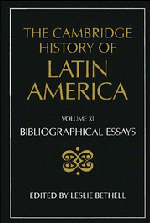Book contents
- Frontmatter
- I THE INDIGENOUS PEOPLES OF MIDDLE AND SOUTH AMERICA ON THE EVE OF THE CONQUEST
- II COLONIAL SPANISH AMERICA
- III COLONIAL BRAZIL
- IV THE INDEPENDENCE OF LATIN AMERICA
- V LATIN AMERICA: ECONOMY, SOCIETY, POLITICS, c. 1820 TO c. 1870
- VI LATIN AMERICA: ECONOMY, SOCIETY, POLITICS, c. 1870 to 1930
- VII LATIN AMERICA: ECONOMY, SOCIETY, POLITICS, 1930 to c. 1990
- VIII IDEAS IN LATIN AMERICA SINCE INDEPENDENCE
- IX LATIN AMERICAN CULTURE SINCE INDEPENDENCE
- 1 Art and literature, c. 1820–c. 1870
- 2 Art and literature, c. 1870–1930
- 3 Narrative since c. 1920
- 4 Poetry since c. 1920
- 5 Indigenous literatures and cultures in the twentieth century
- 6 Art and architecture since c. 1920
- 7 Music since c. 1920
- 8 Cinema
- 9 The mass media
- X THE INTERNATIONAL RELATIONS OF LATIN AMERICA SINCE INDEPENDENCE
- THE CAMBRIDGE HISTORY OF LATIN AMERICA
5 - Indigenous literatures and cultures in the twentieth century
from IX - LATIN AMERICAN CULTURE SINCE INDEPENDENCE
Published online by Cambridge University Press: 28 March 2008
- Frontmatter
- I THE INDIGENOUS PEOPLES OF MIDDLE AND SOUTH AMERICA ON THE EVE OF THE CONQUEST
- II COLONIAL SPANISH AMERICA
- III COLONIAL BRAZIL
- IV THE INDEPENDENCE OF LATIN AMERICA
- V LATIN AMERICA: ECONOMY, SOCIETY, POLITICS, c. 1820 TO c. 1870
- VI LATIN AMERICA: ECONOMY, SOCIETY, POLITICS, c. 1870 to 1930
- VII LATIN AMERICA: ECONOMY, SOCIETY, POLITICS, 1930 to c. 1990
- VIII IDEAS IN LATIN AMERICA SINCE INDEPENDENCE
- IX LATIN AMERICAN CULTURE SINCE INDEPENDENCE
- 1 Art and literature, c. 1820–c. 1870
- 2 Art and literature, c. 1870–1930
- 3 Narrative since c. 1920
- 4 Poetry since c. 1920
- 5 Indigenous literatures and cultures in the twentieth century
- 6 Art and architecture since c. 1920
- 7 Music since c. 1920
- 8 Cinema
- 9 The mass media
- X THE INTERNATIONAL RELATIONS OF LATIN AMERICA SINCE INDEPENDENCE
- THE CAMBRIDGE HISTORY OF LATIN AMERICA
Summary
sources and interpretation
As a succinct introduction to American culture and its place in the world, Claude Lévi-Strauss’s essay, ‘Race et histoire’ (1952), published in translation in Structural Anthropology, vol. 2 (Harmondsworth, 1978), remains unsurpassed; it has the historical underpinning lacking in the four structuralist volumes of his Mythologiques (Paris 1964–71). Joseph H. Greenberg, Language in the Americas (Stanford, Calif., 1987) has now laid the foundation for defining American culture in the joint terms of linguistics and genetics. Michael Closs, Native American Mathematics (Austin, Tex., 1985) is the first continental account of this subject. In recent years, América Indígena, the journal of the Instituto Indigenista Interamericano (Mexico), has increasingly accepted native languages and literatures as a key element in culture and education; see issue 50 (1990). A soundly researched though theoretically naive account of script in Mesoamerica is Joyce Marcus, Mesoamerican Writing Systems: Propaganda, Myth and History in Four Ancient Civilizations (Princeton, N.J., 1992). See also, ‘Epigraphy’, ed. V. Bricker, Supplement to the Handbook of Middle American Indians, vol. 5 (Austin, Tex., 1992); and Elizabeth Boone and Walter Mignolo (eds.), Writing without Words: Alternative Literacies in Mesoamerica and the Andes (Durham, N.C., 1994). Facsimiles of nearly all the major codices have been published by the Akademische Druck-und Verlags Anstalt (ADEVA) in Graz. The recent spate of decipherments of Maya hieroglyphic script is reported in Michael Coe, Breaking the Maya Code (New York, 1992), and touched on in Miguel León-Portilla, Time and Reality in the Thought of the Maya (Norman, Okla., 1987).
- Type
- Chapter
- Information
- The Cambridge History of Latin America , pp. 925 - 933Publisher: Cambridge University PressPrint publication year: 1995

